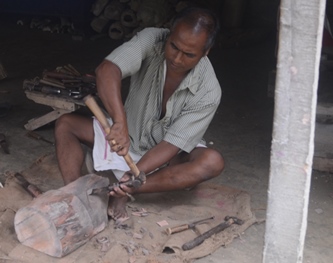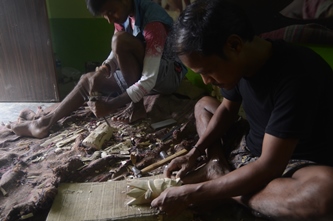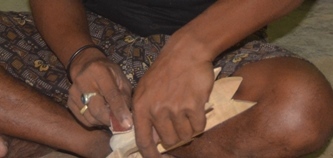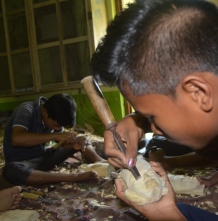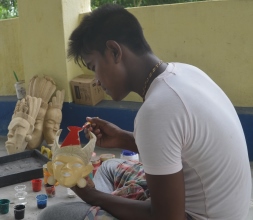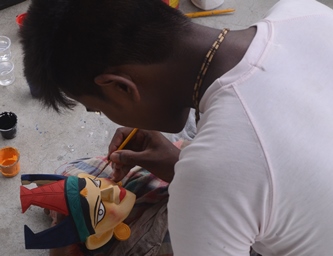Process
The items and the tools that the artists use are Banshla, Broad Chisel, narrow chisels, router chisels, heavy hammer, light hammer, gouges and sand paper.
Step 1 :
The wood is usually purchased from a nearby sawmill or sometimes cut from a tree by the craftsman himself. The village craftsmen are very conscious of the environment and keep on planting trees. The masks are produced through an elaborate process.
Step 2 :
The mask making begins with cutting the log of wood, given the sizes of masks; the initial piece of wood is about 18 feet to 2 4 feet. A chunk of wood is split with machines into blocks of 3-4 feet. This is then immersed in water for seasoning, which renders the wood soft and thus, subsequent cutting and crafting becomes easier. The basic form emerges first with the use of a sharp tool called Banshla or adze.
Step 3:
This is followed by the use of a broad chisel and hammer to bring out the final shape. Once the broad structure of the front of the mask is complete, the reverse side is chiseled to fit the face of the wearer. Chisels are used to gouge out cavities such as the opening of the mouth and eyes. If the mask is to be used for the purpose of dancing, only then the eyes, mouth, etc are hollowed out.
Step 4:
The final procedure involves fine chiseling of the entire mask. This whole process takes about 4-5 days, or more depending upon the complexity of the mask. Once the mask is complete, then comes finishing; the first step to which is smoothening of the mask, which is done by using sand papers of various grades.
Step 5:
Next, the mask gets a coat or two of natural varnish, which provides smoothness to the mask and ensures durability. They mostly use Terpenes which is collected from the locally available Pine tree. Many a times the masks are sold in this condition itself. In case the masks are to be sold to the Gomira dance performers, they need to be handpainted, in colours particular to the characters to be portrayed. Depending on requirement, masks are painted. For example, the character of Jambuban is always painted in deep violet.
